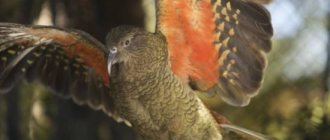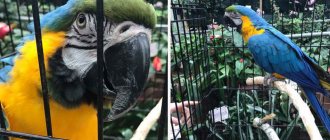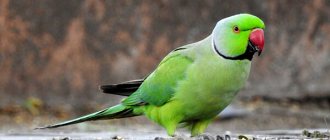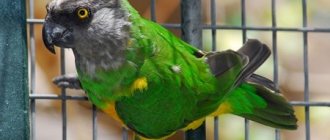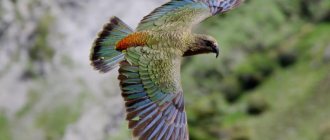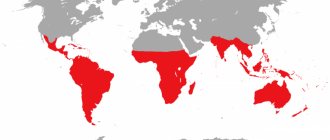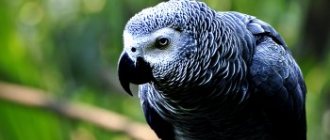The blue macaw is a rare species of parrot and is on the endangered list. Representatives of the species disappeared from the wild by the end of the 20th century, but to this day about a hundred individuals have survived from private breeders. Why did it happen that the blue macaw population was under threat of destruction? To answer this question, you need to get to know these beautiful birds better. The article contains basic information about these interesting parrots: what they look like, what their lifestyle is, what measures are being taken to increase their numbers.
Brief description and appearance
The blue macaw is the only representative of its species. The individual weighs 400 g, the length from beak to tail is 55-57 cm. The feathers are faded blue. The plumage on the head is light gray, the belly and chest are turquoise. There are no feathers between the eyes and the beak. The skin in this area is dark gray. The coloring on the ears and forehead is much lighter.
Description and appearance of the Blue Macaw
The flight feathers and tail feathers are dark blue. The beak is black. Eyes with yellow iris. Paws are gray. In young parrots, a white stripe resembling a protruding bone is clearly visible in the middle of the beak. Their irises are dark. With age, the beak becomes monochromatic, the color of the iris turns yellow.
It was first described by Johann von Spix in the 19th century. A German scientist mistakenly classified the bird as a hyacinth macaw. But the parrot was given the name "Speaks' Blue Parrot."
Reproduction
Hyacinth macaws are monogamous creatures. They create pairs for life. Starting from the age of seven, parrots begin to give birth.
The female lays 2 eggs, less often 3. After 24-27 days, the chicks hatch. According to the cruel laws of nature, only one will survive. In 90% of cases it will be the first-born. The eldest chick will always be first in line for feeding, leaving no chance for its brothers or sisters.
In rare cases (attack by predators, falling out of the nest, infection), the first-born may die and then the second-oldest will take its place. It is for this purpose that nature provides for the laying of several eggs by the female.
What you need to know about parrot breeding
In captivity, when there is no shortage of food, all chicks grow into healthy birds.
The hatchlings are blind and naked. They become covered with feathers in the region of 100-110 days. At the same time, they can fly and get their own food. But for another 3 months they will be under the care of their parents. After this period, the chicks fly away, and the cycle of reproduction of offspring begins anew.
Habitat and lifestyle
They lived in the wild on the American continent, in Brazil, between the Parnaiba and San Francisco rivers. In 2000, the death of the last free bird was recorded. It was a male. There are about 70 individuals of these birds left in zoos and private owners. There is little information about their life in freedom. It is known that they preferred flat terrain with sparse trees, thorny bushes, palm groves, river banks, and forest belts.
Lifestyle of the Ara parrot
The limited habitat depends on the location of the tabebuya tree's habitat. The parrots settled in the hollows and ate the seeds. The dense crown hid from the heat, served as a place to spend the night, and protected from predators.
The diet is varied.
Blue macaws eat:
- fruits;
- cactus berries;
- nuts;
- tree seeds.
A strong beak allows it to cope with hard shells. Brazil nuts are a favorite delicacy.
In nature, the macaw parrot is tied to a tree, in the hollow of which it has built a nest. This is where babies are born. A pair of parrots can use the same place for several years in a row. The female hatches the chicks, and the male brings her food and protects her.
Parrot habitats
Mating games begin in April-May. Courtship is a real ritual. Birds sit on a branch, face to face. Gently finger the feathers on the crown, neck, and under the tail of the chosen pair. They make sounds that resemble a quiet gurgle. The males seem to dance, turn their heads, throw them back on their backs.
The clutch usually contains 2-3 eggs, 5 cm long and 3.5 cm wide. The incubation period takes 24-26 days. The chicks hatch naked and blind. They fledge by 4 months, but their parents feed them for some time.
Important! When danger appears, these birds fall and pretend to be dead, which saves their lives.
Lifestyle
Information about the lifestyle of blue macaws is not yet sufficient. Scientists know the following:
- They prefer to live in small groups.
- In the natural environment they nested in the hollows of large trees.
- Forest clearings with tall trees standing alone among them, small palm groves or groups of trees growing along rivers were chosen as places to live.
Blue macaws feed on all kinds of fruits, seeds and nuts. Thanks to their strong beak, they successfully chew the shell of any, even the hardest, fruit.
Blue macaws live in small groups that break up during the mating season. Their way of life is secretive. At night they take refuge in the crowns of trees. The same is often done during hot daylight hours. Their character is quite peaceful, however, if you annoyingly interfere with the rest of tired parrots, they can become aggressive.
Populations and species status
The blue macaw is not found in the wild. It has been assigned the status of extinct. It also has several other varieties of parrots that have disappeared forever from the face of the Earth:
- The Guadalupe Macaw is known from descriptions by Dutert and Jean-Baptiste Labat. Outwardly he resembled a red macaw. Habitats: the islands of Martinique and Guadeloupe. By 1760 they had completely disappeared.
Blue Macaw Population - Yellow-green Jamaican macaw. Described by the English scientist Philip Henry Gosse. Lived only in Jamaica. The last time he met people was in the 19th century.
- The Carolina parrot has an orange-red head and sides and is a beautiful green color. Habitat: North American continent. Only representatives of this species lived in those places. The population has been exterminated by humans.
- Newton's ringed parrot. Distribution area: Rodrigues Island.
- Red Jamaican Macaw. Described by Gosse. Some ornithologists suggest that it is a subspecies of the Cuban macaw.
- The Martinique Amazon lived in Martinique. The plumage is green. The belly, chest, crown and back of the head are gray.
- Mascarene parrot. Lived in the Indian Ocean on the Mascarene Islands. It was brightly and variedly colored. The head is lilac-blue, the chest is brown-smoky, the wings are darker than the front. Paler under the tail and under the wings. The middle 12 tail feathers are black and brown, and 5 on each side are colored one-quarter white.
- Norfolk kaka. Habitat: mountainous areas of Norfolk Island. The color of the plumage was dominated mainly by brown, orange and yellow shades.
- Paradise parakeet. Red, yellow, turquoise, green shades of plumage made the bird elegant and beautiful. Lived in Australia. Believed to be recently extinct.
Parrot species status - Rodriguez's parrot had green plumage, with red areas on the head, wings, and tail. Settled on the Mascarene Islands. The extinction of the species occurred in the mid-18th century.
- Seychelles ringed parrot. The last individual died at the beginning of the last century. The habitat was located on the islands of Silhouette and Mahe.
- The Cuban tricolor is a large bird up to 0.5 m in size. Bright red, with a yellow nape and a yellowish-red head.
- Purple Amazon. Lived only in Guadeloupe. No details are known about him.
- Guadalupe aratinga. Small bird. The color of the feathers is mainly green. The head was decorated with a red spot. It was common in Guadeloupe. Disappeared in the 18th century.
Scientists have classified flightless kakapo or owls living in New Zealand as endangered birds. In 1999 there were only 62 adults and 6 chicks. Ornithologists sounded the alarm. They began to protect the birds. In 2021, the population numbers 147 adults and 70 chicks. There is hope that future generations of the planet's inhabitants will be able to see these interesting and funny parrots.
Look like twins
The blue-and-yellow macaw is considered one of the largest representatives of the genus. With a body and tail length of 95 cm, its weight reaches one and a half kilograms. The name of the species speaks for itself - this macaw has blue wings, back, neck and head. The lower part of the body is yellow. The bare skin on the “face” is gray or white with small black feathers. It is interesting that parrots of this species live either in pairs or in splendid isolation. They do not flock like many other birds.
The Blue-throated Macaw looks almost identical to the Blue-and-Yellow Macaw. But his blue plumage also forms a collar around his neck. The skin on the cheeks is gray, and around the eyes there are decorations of dark green feathers arranged in stripes.
In size, it is inferior to the blue-yellow macaw by as much as 10 cm. However, both species have light yellow eyes and a black beak. The parrot opens the mating season in December and ends in April. The blue-throated macaw chose the tropical forests of Bolivia for its permanent residence, but is also found in neighboring countries.
What led to the death of the species
Blue macaws became famous and famous after the release of the cartoon "Rio". It became popular, and its funny characters were loved by the audience. But at that moment the parrot became extinct in nature. It was preserved only in captivity.
https://www.youtube.com/watch?v=OFtzScC99Nw
There are several reasons for the disappearance:
- felling of tabebuia for agriculture;
- the widespread African bees began to settle in the hollows of the remaining trees;
- poaching (each individual was valued at up to $40,000).
Only names left
The Martinique Macaw was last mentioned in eyewitness accounts in the 16th century. However, the description itself was compiled only three hundred years later. No remains of the parrot could be found. But in his name he immortalized the island where he supposedly lived. British zoologist Rothschild (better known as a banker and financier) made a scientific description of the species without any evidence of its existence. It’s difficult to say now what the Martinique Macaw was like, but if you believe this description, the bird was very similar to a blue-and-yellow macaw.
Some researchers also consider the blue-gray hyacinth macaw to be extinct, since it has not been seen since the end of the 20th century. And once upon a time it could often be found in the rural areas of Argentina and Brazil.
If the article was useful to you, please like it.
If you know more about macaw species than we do, please share your knowledge in the comments.
Captivity
Blue macaws easily tolerate life in a cage. Playful and good-natured birds quickly get used to their neighbors. It is better to keep them in pairs. This will allow you to get offspring and prevent the birds from getting bored.
In order for your feathered pet to live well in a cage, create suitable conditions:
- the size of the cage must correspond to the size of the resident;
- change food and water daily;
- food – varied;
- parrots love to swim, provide them with a basin or bath for water treatments;
- let them walk around the room;
- They cannot tolerate noise and shouting (aggression manifests itself), so keep quiet.
The most expensive parrot in the world
In captivity, they need to be fed fruits and vegetables. They love rose hips, pears, apples, carrots, cucumbers, raspberries, and corn. The diet should contain nuts, grain mixtures containing millet, oats, millet, and hemp seeds. To replenish macroelements in the body, you need to place a container with shell rock, chalk or pebbles in the cage.

